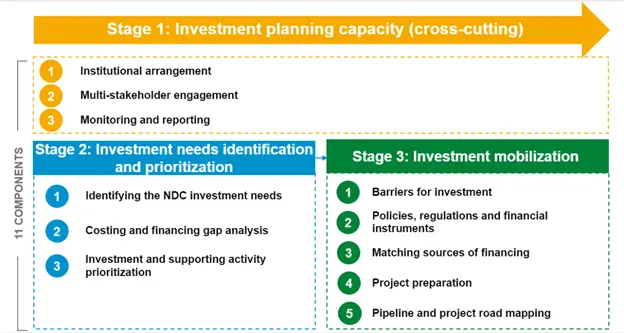Lessons from Belize's NDC Investment Planning: An Integrated Approach to Accessing Climate Finance
Accessing climate finance is an important pre-requisite to achieving the ambitious climate targets outlined in countries' Nationally Determined Contributions (NDCs). Often, accessing climate finance involves a complex and iterative process comprised of different stages from needs identification and prioritization to investment mobilization and planning. Building on existing strategies and the increased ambition of their updated NDC, the Government of Belize embarked on a process to translate national climate and development priorities into sound planning frameworks, institutional arrangements, and concrete project opportunities to mobilize climate finance from diverse sources.
This experience provides relevant insights for other countries’, illustrating how the country adopted an integrated approach to accessing climate finance, enhancing national capacities and coordination mechanisms and maximizing other sectoral development plans and policies to unlock wider sustainable development.
Central to this process is Belize’s National Climate Finance Strategy, providing a critical framework to access and mobilize NDC investment, complementing the country’s NDC Implementation Plan. Belize’s National Climate Finance Strategy contains three key stages as outlined in the figure below.

Investment Planning Capacity
Belize dedicated significant efforts into building its institutional capacity to mobilize investments for its updated NDC. To this end, the government established a key coordinating institution, the Belize National Climate Change Committee (BNCCC), to oversee the country’s climate action and finance priorities and act as the main monitoring body for climate change programs. The BNCCC is supported by the National Climate Change Office (NCCO) with NDC updates, implementation, and monitoring progress toward NDC targets.
Belize’s National Climate Finance strategy was developed through extensive stakeholder consultation, including national, regional, and international agencies. Each of the analyses and documents that supported the national Climate Finance Strategy were created in close engagement with relevant partners through inception workshops, topic-specific consultations, and validation workshops.
The NDC Implementation Plan complements National Climate Finance strategy as a results-based framework that allows for tracking and reporting on progress, supported by the Online Partnership Plan tool. Each objective within the Implementation Plan is accompanied by a Performance Indicator. The indicators are bespoken to the sector and task and can be quantitative or qualitative.
Investment Needs Identification and Prioritization
Belize’s NDC Implementation Plan and National Climate Finance Strategy summarize the investments needed to achieve NDC targets, identified through detailed sectoral analyses and stakeholder engagement. A Climate Change Stakeholder Survey was carried out to identify on-going adaptation and mitigation activities, needs and gaps. The survey involved 44 government and non-governmental organizations that either had the most impact on climate change or were the most vulnerable to its effects. For example, the Women’s Commission was consulted as part of the process, representing the diverse stakeholders who were involved to speak for the needs of vulnerable groups.
As a first step to address the financing gap, Belize undertook an assessment of the Climate Finance Landscape, specifically evaluating domestic climate finance (both public and private) as well as international sources to understand where funding is going and what the gaps are.
In parallel, the country also conducted an analysis of resource requirements, estimating the financial and human requirements for implementing NDC’s adaptation and mitigation measures. Initial costs for the financing gap were obtained from policy documents, sectoral strategies, or project documents where available. When unavailable, a) known costs of activities were scaled or, b) costs were estimated from relevant international or local examples and adjusted to Belize’s context. Stakeholder consultations helped in preparation and validation of cost estimates. For example, stakeholder consultations with the Ministry of Transport resulted in an estimated additional US$10 million for EV charging infrastructure costs. The resulting Resource Requirements Report lists specific projects which have secured funding and estimates that the funding gap is close to USD 1.4 billion.
Investment mobilization
Belize also offers relevant insights into how the NDC investment planning process can be prepared to deliver effective results. Belize’s National Climate Finance Strategy outlined challenges in accessing climate finance. Barriers included domestic capacity for co-financing, institutional coordination, tracking of climate finance, private sector engagement, and local capacity gaps. Medium- and short-term key actions to respond to identified barriers were proposed. Likewise, funding sources were systematically mapped out, providing clarity in terms of climate investment flows in Belize for 2015-2019, originating from multilateral development banks (40%), bilateral donors (21%), climate funds (11%), government budget (9%), private investors (3%) and others (16%).
The way forward
Increasing and further diversifying available sources of finance is going to be critical for advancing Belize NDC investment planning process. As a next step, Belize also showcases effective practices in building the institutional capacity for resource mobilization through project development. A new Climate Finance Unit will better position the country to lead project development as well as put in place a comprehensive measurement, reporting and verification (MRV) system to track climate finance flows and utilization. These arrangements are critical in building the foundation for translating priorities into concrete investment opportunities for the NDC, as well as to ensure communication and cooperation across ministries, sector stakeholders, and further actors of relevance for the NDC implementation process.
